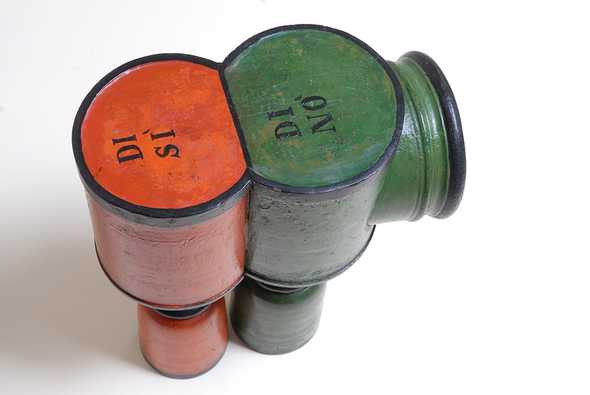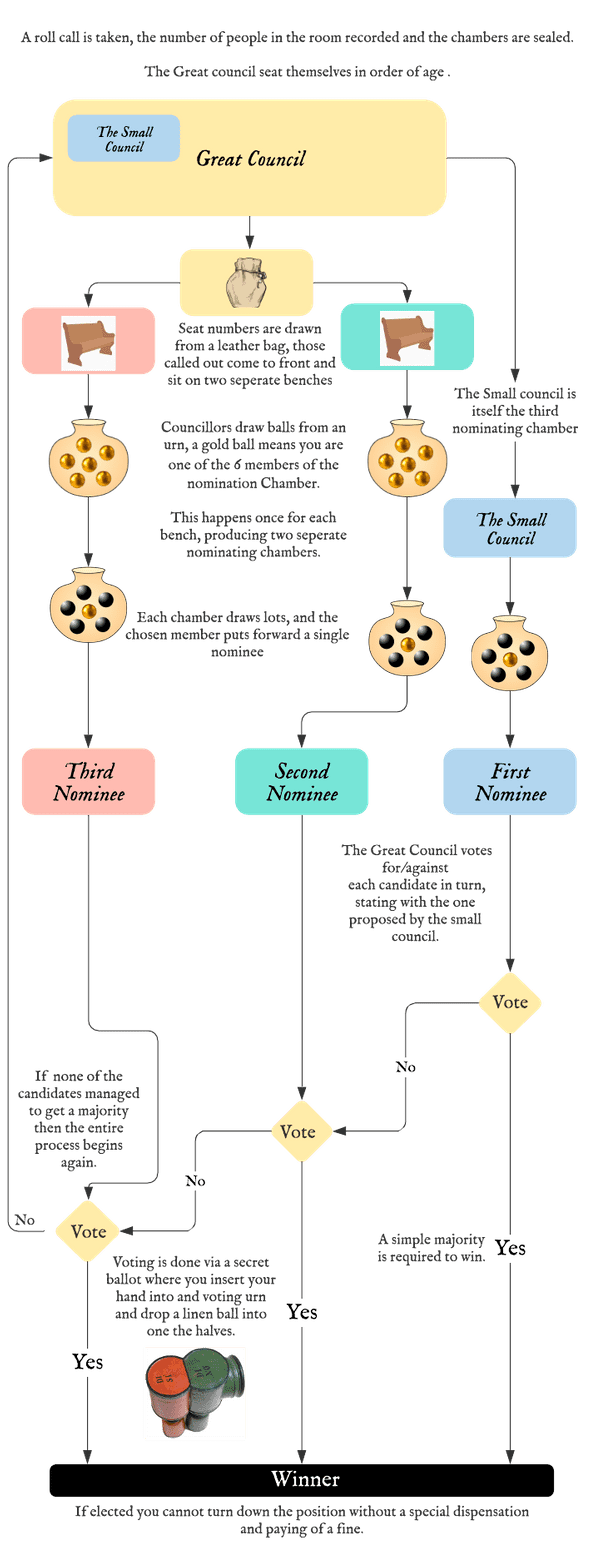Ragusan Elections
April 13, 2021
We come finally to a detailed description of how Ragusan elections were carried out. When reading this it is worth bearing in mind the scale of the city and how it influences what kind of election system was possible or desirable. There were probably only 250 members of the small council, with not all of them being in the city for a given election so we are dealing with something near the upper bound of Dunbar’s number and they could all comfortable fit in a room.
Election in Chambers
The night before an election is to take place the book containing those eligible to attend, the mirror, is consulted and summons are sent out to all those who needed to attend. The next morning three rings of the bell summons all of the members of the great council to the council chambers, where they would sit themselves on 8 benches ordered by age. Next a roll call is carried out and each person is given a ball to place into an urn while stating their name. A count of this urn provides the number of people currently present in the room, and at this point the chambers are sealed with entering/exiting forbidden unless you have the approval of the Rector and small council. This is followed by a speech by the Rector reminding people of their duty honorably, after which each councillor one by one swears an oath on the statutes of Ragusa. With this preamble out of the way the election proper can begin.
First the position under consideration is called out, then a leather bag filled with numbered tokens is brought forward. A secretary proceeds to draw numbers out of the bag, each number corresponding to a seat currently occupied by one of the councilors sitting on the 8 benches. Each councilor who had his seat number drawn comes to the front and sits one of two benches. Once the benches are full a second round of selection by chance begins. Each person on the benches comes forward one by one and draws a ball out of an urn containing a mixture of six gold and a number of black balls. If you draw a gold ball then you become a member of the final nominating chamber, if not you return to your seat. This happens once for each bench, so at then end of this there are two separate 6 man nomination chambers.
These nominating chambers are so named because originally they would actually move to separate chambers when selected to deliberate as a group on who then would nominate for a position. By the 17th century this had been streamlined to be two benches on opposite sides of the room and instead of deliberation there was a third and final round of drawing lots. One person would be randomly selected from the chamber and they would simply put forward a candidate for the position. This would happen for the two previously described nominating chambers, with the small council being the third and final chamber. Once this was complete there would be three candidates named for the position to fill and the casting of votes by the entire great council could take place.
Starting with the candidate proposed by the small council, his name would be called out and he and his close family would then have to leave and wait outside the hall till the voting had finished. Then each member of the council would be handed a small linen ball (soft so as not to be audible when dropped), this ball was then used to cast a vote. In turn each councillor would insert their hand into a voting urn which was split into two halves, dropping your ball into red half was a vote in support of the candidate and a ball dropped in the green half a vote against.

The cups containg the balls at the bottom of the urn would be removed and the votes counted. If the candidate got a simple majority of yes votes, then congratulations they were just elected. If not, then the candidate was unsuccessful and the voting would commence for the next candidate, starting with calling out his name and him leaving the hall. If at the end of the voting for the third candidate no-one had managed to achieve a majority, the entire procedure would start again from the very beginning with the initial drawing of numbers from the leather bag etc.
Attempting to solicit votes or electioneering was explicitly forbidden by law with penalties including fines and imprisonment prescribed as well as an up to 6 year exclusion from holding public office. The concern around corruption was taken seriously and you can see how parts of the electoral system is set up to try and prevent it. Councillors were not allowed to address the nominating chambers, the sealing of the council chambers prevented people finding a quiet corner for horse trading and the fact that nomination was directly followed by the voting left a very small window for any chicanery to take place.
Election by Scrutiny
A simpler form of direct election was used for some positions, generally for posts outside of the city. Starting at different parts of the hall for different positions, the chancellor would walk up to each councillor who could whisper a name into his ear. The councillor had with him a loop of paper which was wound around a wooden stick, so that writing down names on this paper would produce a final list that was effectively in random order. After completing his circuit of the room, all councillors would of been given a chance to nominate someone and the voting could begin. Anyone who received more than 5 nomination was a valid candidate, and yes/no voting as described above would begin. Initially this was done on a name by name basis with the council as a whole not knowing ahead of time what the full list of candidates for the position were, but over time this was modified to publicly announce all of the candidate before voting started.
By the 16th century this nomination method was dropped entirely and in its place three members of the council were selected at random to secretly nominate a candidate.
Harris, Robin. 2006. Dubrovnik: a history. London: Saqi Books.
Lonza, Nella. “Election Procedure in the Republic of Dubrovnik.” Dubrovnik annals , br. 8 (2004): 7-41. https://hrcak.srce.hr/19725
